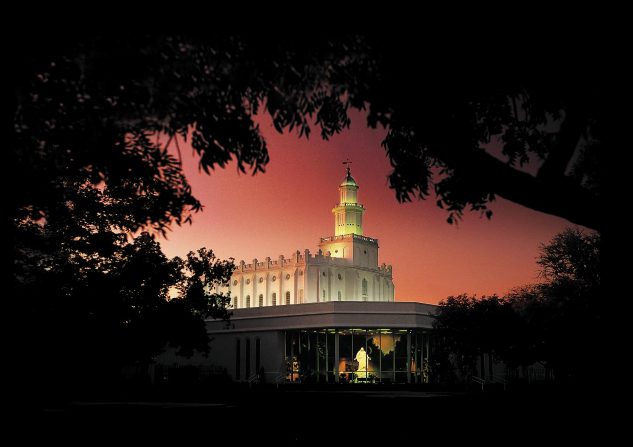
A few hours ago, I posted an item about the ongoing controversy regarding monuments to leaders of the Confederacy, and predicted that it will soon spread far beyond the legacy of the American Civil War:
“The Forthcoming Mormon Memory Wars”
Even if we look only at the battle over the legacy of the Confederacy, though, and if the following story is accurate, things are becoming exceptionally weird:
“ESPN blasted for political correctness after pulling announcer Robert Lee from UVa football game”
(Sorry. I’ve misplaced my note about who called my attention to this.)
“Protesters on Replicas of Christopher Columbus Ships: Those are Black Ships of Death”
And then, back to Mormondom, there’s this:
On which, a few observations:
- All other things being equal, diversity is a pretty good thing. But it’s not the only good thing. It’s not even, in my view, the most important good thing.
- If non-whites weren’t permitted to enter or live in southern Utah, that would be shameful. That they choose, for whatever reasons of their own, not to take up residence there is mildly interesting. But it’s scarcely scandalous or horrible. People are free to live with, and to associate with, whomever they prefer. (I had an Israeli friend in graduate school who was interested in job offers only from places with sufficiently large Jewish population and with a vibrant Jewish life. That’s fine. His choice. I’m sure that many blacks would choose analogously. And that’s their right. But it means that there will be considerable inertia in the racial demographics of various communities. Jewish communities will tend to remain Jewish, as black communities will tend to remain black, Asian communities will tend to remain Asian, Mormon communities will tend to remain Mormon, and small, religiously and ethnically homogenous communities will tend to remain religiously and ethnically homogenous.
- I object to the term pitiful, which the author uses twice. There is nothing “wrong,” nothing “pitiful,” nothing intrinsically inferior about the fact that Jefferson County, Mississippi, is 86.49% black, or that Detroit, Michigan, is 84.3% black. Are non-blacks legally barred from Detroit or from Jefferson County? Have they been driven from those places by force? If not, then their low numbers are moderately interesting but pose no substantial moral or legal issue.
- I also object, yet again, to equations of Robert E. Lee and Stonewall Jackson to “Adolph [sic] Hitler and Osama bin Laden.” I’m happy that the Union won the Civil War and that black slavery was ended, but the Confederate States of America simply weren’t the American equivalent of the Third Reich.
- I’m not surprised that Church leaders would seek to raise their own cotton during the American Civil War, when supplies of that material, so vital for the production of clothing, were threatened. They were, after all, still trying to make Deseret self-sufficient. My understanding is that efforts to grow cotton in the Washington County area weren’t so much a greedy attempt to grab “a cut of the lucrative trade” as an experiment designed to help clothe the rapidly growing Mormon population of the Great Basin and to support the struggling settlements in what is today southern Utah. (That sounds rather less contemptible than the author’s formulation does.)
- I’m not surprised that, if they were hoping to grow cotton, Church leadership called someone to lead the enterprise who had prior experience with the growing of cotton. Had they instead called a furniture maker or a music teacher or a bookkeeper with absolutely no cotton-growing background, they would, today, be criticized and ridiculed by a certain strain of critic for that.
- Was Robert Dockery Covington a former slave overseer? Very possibly. I know nothing about him. Was he still in favor of slavery after his conversion to Mormonism and his arrival in Utah? I have no idea. I know nothing about him. Was he a slave overseer while living in southern Utah? I doubt it very much. Yet I think the answer to that question quite relevant.
- I don’t think it’s even remotely just or fair for the article’s author to try so very hard to link southern Utah with the evils of slavery and the Confederacy, let alone with the Ku Klux Klan and neo-Nazis.
- Nor do I appreciate the unmistakable whiff of anti-Mormonism given off by the article.
- And I object to what I’m coming to see as a powerful (predominantly leftist) urge to demonize our past, both American and specifically Mormon. Were our predecessors flawed humans? Yes. Certainly. But so are we. So I hope we can show some charity to them — if for no other reason than the fact that we, ourselves, must hope for charity from those flawed humans who will follow us and who will marvel at not only our weird hairstyles and our ridiculous clothing but our moral blindspots, our intellectual quirks, and our cultural limitations.
- Finally — and there’s much more that I could say — I think it overwrought to describe the United States of America in 2017 as “a racial powder keg with Ku Klux Klansmen and neo-Nazis marching on one side and [in the author’s view, virtuous] social activists on the other.” I don’t say that we’ve attained racial utopia, and I haven’t been happy to see the emergence of the alt-right, but, on the whole, twenty-first century America is a far more racially unified, tolerant, and inclusive place than it has ever been in its history. Exaggeration doesn’t help things at all. There are scores of millions of people, neither white supremacists nor saintly leftist activists, who are working in integrated companies, raising their children in integrated communities, and too busy to spend much time marching in angry demonstrations.
Posted from San Diego, California











